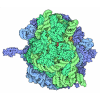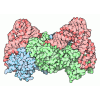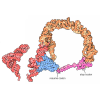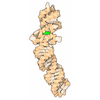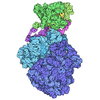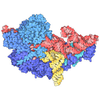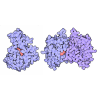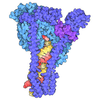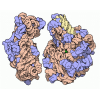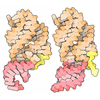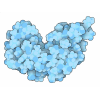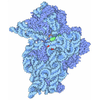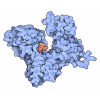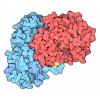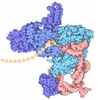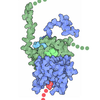+ Open data
Open data
- Basic information
Basic information
| Entry | Database: PDB / ID: 9hn9 | ||||||
|---|---|---|---|---|---|---|---|
| Title | Mouse QTRT1/2 in complex with mouse pre-tRNA-Tyr-1-4 | ||||||
 Components Components |
| ||||||
 Keywords Keywords | RNA BINDING PROTEIN / queuosine / tRNA / QTRT1/2 / tRNA modification | ||||||
| Function / homology |  Function and homology information Function and homology informationtRNA-guanosine34 queuine transglycosylase / tRNA-guanine transglycosylase complex / cytoplasmic side of mitochondrial outer membrane / tRNA-guanosine(34) queuine transglycosylase activity / : / tRNA binding / protein heterodimerization activity / protein homodimerization activity / protein-containing complex / mitochondrion ...tRNA-guanosine34 queuine transglycosylase / tRNA-guanine transglycosylase complex / cytoplasmic side of mitochondrial outer membrane / tRNA-guanosine(34) queuine transglycosylase activity / : / tRNA binding / protein heterodimerization activity / protein homodimerization activity / protein-containing complex / mitochondrion / zinc ion binding / metal ion binding / nucleus / cytoplasm Similarity search - Function | ||||||
| Biological species |  | ||||||
| Method | ELECTRON MICROSCOPY / single particle reconstruction / cryo EM / Resolution: 3.1 Å | ||||||
 Authors Authors | Kaczmarczyk, I. / Koziej, L. / Glatt, S. | ||||||
| Funding support | European Union, 1items
| ||||||
 Citation Citation |  Journal: Nat Commun / Year: 2025 Journal: Nat Commun / Year: 2025Title: Queuosine is incorporated into precursor tRNA before splicing. Authors: Wei Guo / Igor Kaczmarczyk / Kevin Kopietz / Florian Flegler / Stefano Russo / Ege Cigirgan / Andrzej Chramiec-Głąbik / Łukasz Koziej / Cansu Cirzi / Jirka Peschek / Klaus Reuter / Mark ...Authors: Wei Guo / Igor Kaczmarczyk / Kevin Kopietz / Florian Flegler / Stefano Russo / Ege Cigirgan / Andrzej Chramiec-Głąbik / Łukasz Koziej / Cansu Cirzi / Jirka Peschek / Klaus Reuter / Mark Helm / Sebastian Glatt / Francesca Tuorto /    Abstract: Each newly transcribed tRNA molecule must undergo processing and receive modifications to become functional. Queuosine (Q) is a tRNA modification present at position 34 of four tRNAs with "GUN" ...Each newly transcribed tRNA molecule must undergo processing and receive modifications to become functional. Queuosine (Q) is a tRNA modification present at position 34 of four tRNAs with "GUN" anticodons. Among these, the precursor of tRNA carries an intronic sequence within the anticodon loop that is removed by an essential non-canonical splicing event. The functional and temporal coupling between tRNA-splicing and Q-incorporation remains elusive. Here, we demonstrate in vitro and in vivo that intron-containing precursors of tRNA are modified with Q or with the Q-derivative galactosyl-queuosine (galQ) before being spliced. We show that this order of events is conserved in mouse, human, flies and worms. Using single particle cryo-EM, we confirm that pre-tRNA is a bona fide substrate of the QTRT1/2 complex, which catalyzes the incorporation of Q into the tRNA. Our results elucidate the hierarchical interplay that coordinates Q-incorporation and splicing in eukaryotic tRNAs, providing a relevant but unappreciated aspect of the cellular tRNA maturation process. | ||||||
| History |
|
- Structure visualization
Structure visualization
| Structure viewer | Molecule:  Molmil Molmil Jmol/JSmol Jmol/JSmol |
|---|
- Downloads & links
Downloads & links
- Download
Download
| PDBx/mmCIF format |  9hn9.cif.gz 9hn9.cif.gz | 193.6 KB | Display |  PDBx/mmCIF format PDBx/mmCIF format |
|---|---|---|---|---|
| PDB format |  pdb9hn9.ent.gz pdb9hn9.ent.gz | 142.4 KB | Display |  PDB format PDB format |
| PDBx/mmJSON format |  9hn9.json.gz 9hn9.json.gz | Tree view |  PDBx/mmJSON format PDBx/mmJSON format | |
| Others |  Other downloads Other downloads |
-Validation report
| Summary document |  9hn9_validation.pdf.gz 9hn9_validation.pdf.gz | 1.2 MB | Display |  wwPDB validaton report wwPDB validaton report |
|---|---|---|---|---|
| Full document |  9hn9_full_validation.pdf.gz 9hn9_full_validation.pdf.gz | 1.2 MB | Display | |
| Data in XML |  9hn9_validation.xml.gz 9hn9_validation.xml.gz | 39 KB | Display | |
| Data in CIF |  9hn9_validation.cif.gz 9hn9_validation.cif.gz | 58 KB | Display | |
| Arichive directory |  https://data.pdbj.org/pub/pdb/validation_reports/hn/9hn9 https://data.pdbj.org/pub/pdb/validation_reports/hn/9hn9 ftp://data.pdbj.org/pub/pdb/validation_reports/hn/9hn9 ftp://data.pdbj.org/pub/pdb/validation_reports/hn/9hn9 | HTTPS FTP |
-Related structure data
| Related structure data |  52309MC  9hn7C M: map data used to model this data C: citing same article ( |
|---|---|
| Similar structure data | Similarity search - Function & homology  F&H Search F&H Search |
- Links
Links
- Assembly
Assembly
| Deposited unit | 
|
|---|---|
| 1 |
|
- Components
Components
| #1: Protein | Mass: 43428.980 Da / Num. of mol.: 1 Source method: isolated from a genetically manipulated source Source: (gene. exp.)   Vibrio natriegens (bacteria) Vibrio natriegens (bacteria)References: UniProt: Q9JMA2, tRNA-guanosine34 preQ1 transglycosylase |
|---|---|
| #2: Protein | Mass: 46367.172 Da / Num. of mol.: 1 Source method: isolated from a genetically manipulated source Source: (gene. exp.)   Vibrio natriegens (bacteria) / References: UniProt: B8ZXI1 Vibrio natriegens (bacteria) / References: UniProt: B8ZXI1 |
| #3: RNA chain | Mass: 30001.740 Da / Num. of mol.: 1 / Source method: obtained synthetically / Source: (synth.)  |
| #4: Chemical | ChemComp-9DG / |
| Has ligand of interest | Y |
| Has protein modification | N |
-Experimental details
-Experiment
| Experiment | Method: ELECTRON MICROSCOPY |
|---|---|
| EM experiment | Aggregation state: PARTICLE / 3D reconstruction method: single particle reconstruction |
- Sample preparation
Sample preparation
| Component | Name: Mouse QTRT1/2 in complex with mouse pre-tRNA-Tyr-1-4 / Type: COMPLEX / Entity ID: #1-#3 / Source: RECOMBINANT | |||||||||||||||||||||||||
|---|---|---|---|---|---|---|---|---|---|---|---|---|---|---|---|---|---|---|---|---|---|---|---|---|---|---|
| Molecular weight | Value: 0.12 MDa / Experimental value: NO | |||||||||||||||||||||||||
| Source (natural) | Organism:  | |||||||||||||||||||||||||
| Source (recombinant) | Organism:  Vibrio natriegens (bacteria) Vibrio natriegens (bacteria) | |||||||||||||||||||||||||
| Buffer solution | pH: 7.5 | |||||||||||||||||||||||||
| Buffer component |
| |||||||||||||||||||||||||
| Specimen | Conc.: 0.2 mg/ml / Embedding applied: NO / Shadowing applied: NO / Staining applied: NO / Vitrification applied: YES | |||||||||||||||||||||||||
| Specimen support | Grid material: COPPER / Grid mesh size: 200 divisions/in. / Grid type: Quantifoil R2/1 | |||||||||||||||||||||||||
| Vitrification | Instrument: FEI VITROBOT MARK IV / Cryogen name: ETHANE / Humidity: 100 % / Chamber temperature: 277 K |
- Electron microscopy imaging
Electron microscopy imaging
| Experimental equipment |  Model: Titan Krios / Image courtesy: FEI Company |
|---|---|
| Microscopy | Model: TFS KRIOS |
| Electron gun | Electron source:  FIELD EMISSION GUN / Accelerating voltage: 300 kV / Illumination mode: FLOOD BEAM FIELD EMISSION GUN / Accelerating voltage: 300 kV / Illumination mode: FLOOD BEAM |
| Electron lens | Mode: BRIGHT FIELD / Calibrated magnification: 105000 X / Nominal defocus max: 1500 nm / Nominal defocus min: 600 nm / Cs: 2.7 mm / C2 aperture diameter: 50 µm / Alignment procedure: COMA FREE |
| Specimen holder | Cryogen: NITROGEN / Specimen holder model: FEI TITAN KRIOS AUTOGRID HOLDER |
| Image recording | Average exposure time: 1.82 sec. / Electron dose: 40 e/Å2 / Film or detector model: GATAN K3 BIOQUANTUM (6k x 4k) / Num. of grids imaged: 1 / Num. of real images: 9687 |
| EM imaging optics | Energyfilter name: GIF Bioquantum / Energyfilter slit width: 20 eV |
| Image scans | Width: 5760 / Height: 4092 |
- Processing
Processing
| EM software |
| |||||||||||||||||||||||||||||||||||||||||||||||||||||||
|---|---|---|---|---|---|---|---|---|---|---|---|---|---|---|---|---|---|---|---|---|---|---|---|---|---|---|---|---|---|---|---|---|---|---|---|---|---|---|---|---|---|---|---|---|---|---|---|---|---|---|---|---|---|---|---|---|
| CTF correction | Type: PHASE FLIPPING AND AMPLITUDE CORRECTION | |||||||||||||||||||||||||||||||||||||||||||||||||||||||
| Particle selection | Num. of particles selected: 1933554 / Details: Template picking | |||||||||||||||||||||||||||||||||||||||||||||||||||||||
| Symmetry | Point symmetry: C1 (asymmetric) | |||||||||||||||||||||||||||||||||||||||||||||||||||||||
| 3D reconstruction | Resolution: 3.1 Å / Resolution method: FSC 0.143 CUT-OFF / Num. of particles: 396050 / Algorithm: FOURIER SPACE / Num. of class averages: 2 / Symmetry type: POINT | |||||||||||||||||||||||||||||||||||||||||||||||||||||||
| Atomic model building | Protocol: FLEXIBLE FIT / Space: REAL / Details: Isolde | |||||||||||||||||||||||||||||||||||||||||||||||||||||||
| Atomic model building | 3D fitting-ID: 1
| |||||||||||||||||||||||||||||||||||||||||||||||||||||||
| Refinement | Highest resolution: 3.1 Å Stereochemistry target values: REAL-SPACE (WEIGHTED MAP SUM AT ATOM CENTERS) |
 Movie
Movie Controller
Controller




 PDBj
PDBj